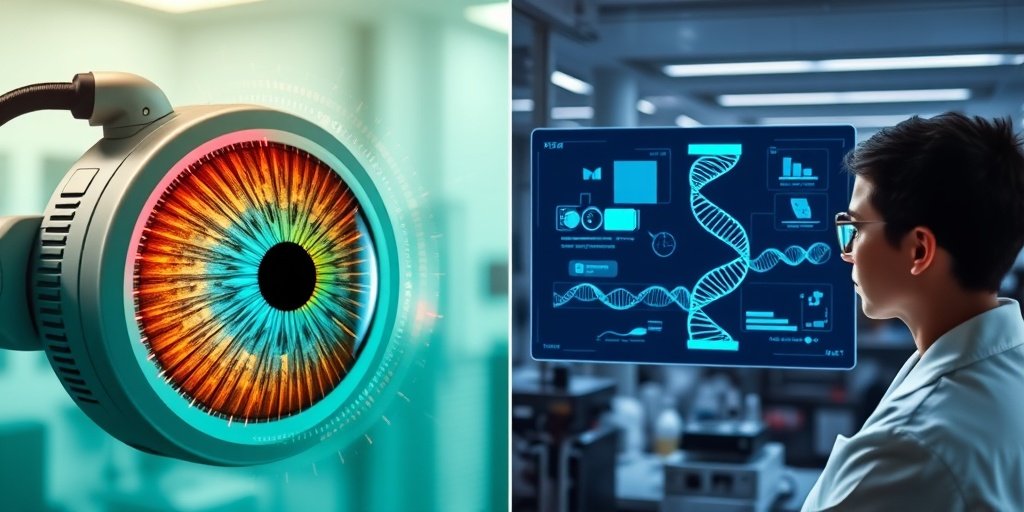⚡ Quick Summary
This article explores the role of artificial intelligence (AI) in diagnosing and managing inherited retinal dystrophies (IRDs), a leading cause of blindness in working-age populations. AI has shown potential in improving diagnostic accuracy and streamlining genetic testing processes, although challenges remain for its widespread adoption.
🔍 Key Details
- 📊 Focus: Inherited retinal dystrophies (IRDs)
- 🧩 Key Technologies: AI-driven models for diagnosis and management
- ⚙️ Applications: Predicting disease-causing variants, segmenting retinal layers
- 🏆 Challenges: High costs, diagnostic delays, and the “black-box” problem
🔑 Key Takeaways
- 👁️ IRDs are a diverse group of genetic disorders leading to vision loss.
- 💡 AI models can predict causative genes and improve diagnostic accuracy.
- 🔬 Current limitations include high costs and inconsistent imaging quality.
- 🌍 Ongoing efforts aim to reduce genetic testing costs and enhance diagnostic yield.
- 🛡️ Barriers to AI adoption include data ownership concerns and clinical safety issues.
- 🔮 Future applications may involve genetic counseling and personalized treatment predictions.
- 🤝 Collaboration among researchers is essential to overcome existing challenges.

📚 Background
Inherited retinal dystrophies (IRDs) encompass a wide range of genetic disorders that significantly impact vision and quality of life. These conditions are characterized by both genotypic and phenotypic variability, making diagnosis complex. Despite advancements in genetic testing, the process remains lengthy and costly, highlighting the need for innovative solutions to enhance diagnostic efficiency and patient outcomes.
🗒️ Study
The authors conducted a comprehensive review of the current literature on AI applications in the context of IRDs. They examined various AI-driven approaches that have emerged to address the challenges associated with diagnosing these complex conditions. The study emphasizes the potential of AI to transform the diagnostic landscape for IRDs, despite the hurdles that still need to be addressed.
📈 Results
AI models have demonstrated significant promise in several areas, including predicting disease-causing variants and segmenting retinal layers. However, the routine clinical adoption of these technologies remains limited. The study highlights ongoing efforts to lower genetic testing costs and reduce diagnostic delays, which are crucial for improving the overall molecular diagnostic yield.
🌍 Impact and Implications
The integration of AI into the diagnostic process for IRDs could revolutionize patient care. By streamlining genetic testing and enhancing diagnostic accuracy, AI has the potential to significantly improve clinical outcomes for patients suffering from these debilitating conditions. However, addressing the barriers to AI adoption is essential for realizing its full potential in the field of ophthalmology.
🔮 Conclusion
This review underscores the transformative potential of AI in diagnosing and managing inherited retinal dystrophies. While challenges remain, continued research and collaboration among stakeholders are vital to overcoming these obstacles. The future of AI in IRDs looks promising, and with further advancements, we may see significant improvements in patient care and outcomes.
💬 Your comments
What are your thoughts on the role of AI in diagnosing inherited retinal dystrophies? We would love to hear your insights! 💬 Leave your comments below or connect with us on social media:
Artificial intelligence applications in inherited retinal dystrophies.
Abstract
PURPOSE: Inherited retinal dystrophies (IRDs) are a heterogeneous group of diseases characterized by genotypic and phenotypic variability and are among the leading causes of blindness in the working-age population in developed countries. Despite advancements in genetic testing, obtaining a molecular diagnosis remains a lengthy and challenging process due to limited resources and high costs. Artificial intelligence (AI) offers promising solutions to streamline diagnostic pathways and improve clinical outcomes.
METHODS: We reviewed current literature on AI-driven approaches in IRDs.
RESULTS: AI models have demonstrated potential in predicting disease-causing variants, distinguishing phenotypically similar IRDs, and segmenting retinal layers. However, their routine clinical adoption remains limited. Efforts are ongoing to lower genetic testing costs, reduce diagnostic delays, and enhance molecular diagnostic yield. Future applications may include genetic counselling, prediction of IRD progression, evaluation of novel mutation pathogenicity, identification of gene therapy candidates, and prediction of personalized outcomes post-treatment. Barriers to widespread AI adoption include a lack of standardized nomenclature, ethnic and regional variations, inconsistent multimodal imaging quality, data ownership concerns, clinical safety, cybersecurity, and the opaque nature of AI decision-making, known as the “black-box” problem.
CONCLUSIONS: AI models have shown promise in diagnosing IRDs, predicting causative genes, and segmenting retinal layers. While AI has the potential to revolutionize IRD diagnosis and management, significant challenges must be addressed. Continued research and collaboration are crucial to overcoming these barriers and unlocking AI’s full potential in IRDs.
Author: [‘Kiraly P’, ‘Fischer MD’]
Journal: Graefes Arch Clin Exp Ophthalmol
Citation: Kiraly P and Fischer MD. Artificial intelligence applications in inherited retinal dystrophies. Artificial intelligence applications in inherited retinal dystrophies. 2025; (unknown volume):(unknown pages). doi: 10.1007/s00417-025-06956-w